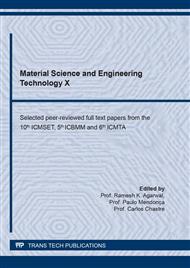p.315
p.323
p.331
p.338
p.345
p.352
p.358
p.367
p.377
The Study on Blast Furnace Slag on Different Conditions as Curing Condition and Blaine Value Ratio Influence Improving Strength Performance
Abstract:
The sustainable building aims to minimize environmental impact by reducing carbon dioxide pollution by using by-products. Concrete materials are well-known for being the most extensively used construction material. Carbon dioxide emissions are the permissible greenhouse gas emissions that would have an impact on the long sustainability. Blast furnace slag reduces carbon dioxide emissions as an environmentally responsible building material, and sustainable steelmaking aims to minimize waste. Steel corrosion and chloride damage are several of the most apparent problems for concrete structure durability. Incorporating BFS into the cement is beneficial for concrete durability as the Structures' serviceability increased. This study aimed to explore the material properties and compressive strength of BFS mortar while considering the replacement ratio, Blaine fineness of the BFS, and curing conditions. This study mainly discovered that substituting BES for cement in the mortar increased the compressive strength and durability factor, indicating that the material's properties depend on the BFS, based on the experimental results, which cover the materials properties and salt preventive property. The low water-to-binder ratio (W/B) of the BFS-blended cement mixture is the reason for this. The study reported that the investigation of salt preventive by adding BFS with a low Blaine fineness and average substitution ratios (45%) could improve the compressive strength of BFS mortar samples. These mortar samples were even more resistant to carbonation, which could also be attributed to the hydration products of BFS.
Info:
Periodical:
Pages:
345-351
Citation:
Online since:
February 2022
Authors:
Keywords:
Price:
Сopyright:
© 2022 Trans Tech Publications Ltd. All Rights Reserved
Share:
Citation:


